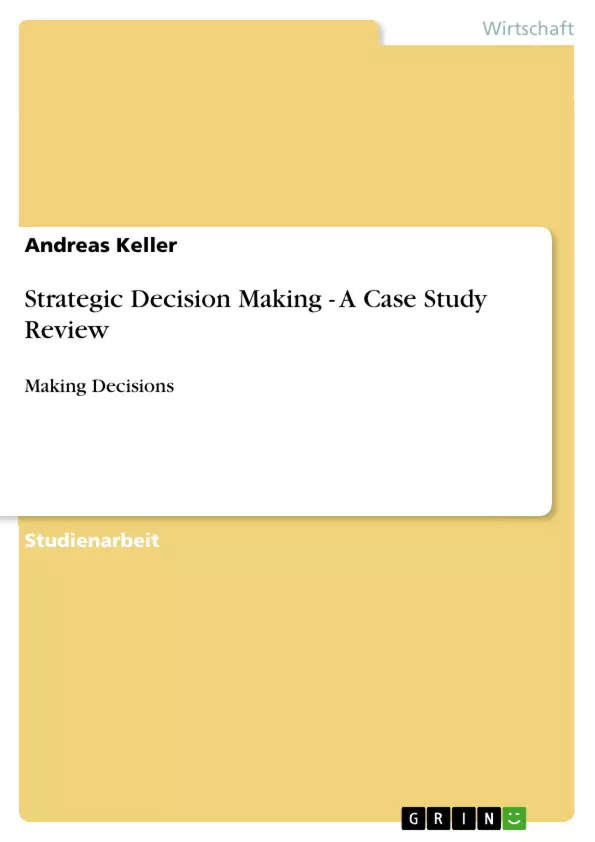This paper describes the potential benefit of decision analysis, a process helping decision makers to gain a deeper understanding of their complex issues they face. Especially in the world of corporate business many decisions are complicated and need to consider a wide range of criteria and issues. Multiple Attribute Value Analysis (MAVA) addresses the issues of problem structuring as a useful support for decision making in practice, and for this purpose I will use V.I.S.A1 software to document and structure the decision making process. This paper is divided into three chapters/tasks.
• Chapter 1: Reports on an investigation into ADMECO’s strategic decision making process
• Chapter 2: Reflections on the use of Multiple Attribute Value Theory (MAVT)
• Chapter 3: A descriptive analysis of a case study: Giving up the smoke: A major institution investigates alternatives to being sited in the city
Inhaltsverzeichnis
- Abstract
- 1.0 Strategic Decision Making Process at ADMECO AG
- 1.1 Problem Description/Objectives
- 1.2 Distribution
- 1.3 Assessment Method With MAVA
- 1.4 Alternatives
- 1.5 Criteria
- 1.6 Scoring
- 1.7 Weighting
- 1.8 Sensitivity Analysis
- 1.9 Recommendation; Course of Action
- 2.0 Reflection on the use of MAVT
- 2.1 Comments/Discussions on the Process of analysis
- 2.2 Alternatives the "Even Swaps" Method
- 2.2.1 Making an Even Swap
- 2.3 Lessons Learnt
- 3.0 Case Study Review
- 3.1 Case Study Background
- 3.2 Discussions & Comments
- 4.0 References
Zielsetzung und Themenschwerpunkte
Diese Arbeit beschreibt den potenziellen Nutzen der Entscheidungsanalyse, ein Prozess, der Entscheidungsträgern hilft, ein tieferes Verständnis ihrer komplexen Herausforderungen zu gewinnen. Besonders in der Welt des Unternehmens sind viele Entscheidungen kompliziert und müssen eine Vielzahl von Kriterien und Themen berücksichtigen. Die Mehrkriterienbewertung (MAVT) befasst sich mit den Problemen der Problemstrukturierung als nützliche Unterstützung für die Entscheidungsfindung in der Praxis. Zu diesem Zweck werde ich Software verwenden, um den Entscheidungsprozess zu dokumentieren und zu strukturieren. Diese Arbeit ist in drei Kapitel/Aufgaben unterteilt.
- Kapitel 1: Berichtet über eine Untersuchung des strategischen Entscheidungsprozesses von ADMECO.
- Kapitel 2: Reflexionen über die Anwendung der Mehrkriterienbewertung (MAVT).
- Kapitel 3: Eine beschreibende Analyse einer Fallstudie: Den Rauch aufgeben: Eine große Institution untersucht Alternativen zu einem Standort in der Stadt.
Zusammenfassung der Kapitel
Das erste Kapitel untersucht den strategischen Entscheidungsprozess von ADMECO AG, einem kleinen Unternehmen für Medizinprodukte, das Konzepte und Lösungen für den Krankenhausmarkt, insbesondere für Operationssäle und Reinraumumgebungen, anbietet. ADMECO strebt danach, seine Vertriebs- und Marketingkanäle in den USA zu erweitern, dem größten Markt für Medizinprodukte weltweit. Der Text analysiert die Herausforderungen, die mit der Auswahl eines geeigneten Distributors/OEM in den USA verbunden sind, und wendet die Mehrkriterienbewertung (MAVT) an, um eine methodische Herangehensweise zur Unterstützung und Validierung von Optionen zu bieten.
Das zweite Kapitel reflektiert über die Anwendung der MAVT und diskutiert die Vor- und Nachteile dieses Ansatzes. Es werden die Herausforderungen bei der Identifizierung relevanter messbarer Kriterien, die Problematik der Gewichtung und die Rolle der Software bei der Visualisierung des Entscheidungsprozesses beleuchtet. Der Text vergleicht die MAVT mit der "Even Swaps"-Methode als eine alternative Entscheidungsstrategie.
Die Fallstudie im dritten Kapitel befasst sich mit der Entscheidung der Bank of England, ihre Registrierungsabteilung außerhalb Londons zu verlegen. Die Analyse untersucht, wie die verschiedenen Standorte bewertet und miteinander verglichen wurden, wobei ein hierarchischer Baum mit 38 verschiedenen Attributen verwendet wurde. Die Fallstudie zeigt, wie die Software HIVIEW den Entscheidungsprozess unterstützt und die Herausforderungen bei der Verwaltung komplexer Entscheidungen mit einer Vielzahl von Kriterien beleuchtet.
Schlüsselwörter
Die Schlüsselwörter und Schwerpunktthemen des Textes umfassen die Entscheidungsanalyse, die Mehrkriterienbewertung (MAVT), strategische Entscheidungsfindung, Problemstrukturierung, Softwareunterstützung, Fallstudien, Vertriebsnetzwerke, OEM, Krankenhausmarkt, USA, Bank of England, Standortverlagerung, HIVIEW, Entscheidungsfindung in der Praxis, Entscheidungsfindung in komplexen Situationen.
- Quote paper
- MBA Andreas Keller (Author), 2003, Strategic Decision Making - A Case Study Review, Munich, GRIN Verlag, https://www.grin.com/document/178452



